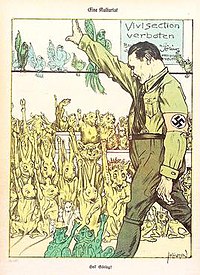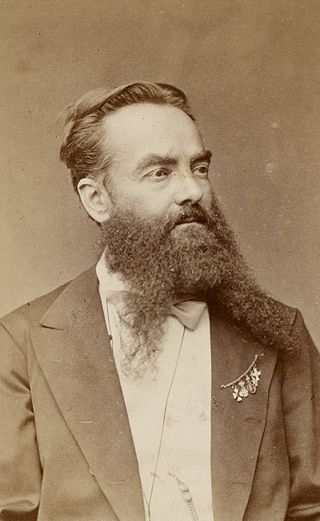Measures
At the end of the nineteenth century, kosher butchering and vivisection (animal experimentation) were the main concerns of the German animal welfare movement. The Nazis adopted these concerns as part of their political platform. [11] According to Boria Sax, the Nazis rejected anthropocentric reasons for animal protection—animals were to be protected for their own sake. [12] In 1927, a Nazi representative to the Reichstag called for actions against cruelty to animals and kosher butchering. [11]
In 1931, the Nazi Party (then a minority in the Reichstag) proposed a ban on vivisection, but the ban failed to attract support from other political parties. By 1933, after Hitler had ascended to the Chancellery and the Nazis had consolidated control of the Reichstag, the Nazis immediately held a meeting to enact the ban on vivisection. On April 21, 1933, almost immediately after the Nazis came to power, the parliament began to pass laws for the regulation of animal slaughter. [11] On April 21, a law was passed concerning the slaughter of animals; no animals were to be slaughtered without anesthetic.
On April 24, Order of the Prussian Ministry of the Interior was enacted regarding the slaughter of poikilotherms. [13] Nazi Germany was the first nation to ban vivisection. [14] A law imposing total ban on vivisection was enacted on August 16, 1933, by Hermann Göring as the prime minister of Prussia. [15] He announced an end to the "unbearable torture and suffering in animal experiments" and said that those who "still think they can continue to treat animals as inanimate property" will be sent to concentration camps. [11] On August 28, 1933, Göring announced in a radio broadcast: [16]
An absolute and permanent ban on vivisection is not only a necessary law to protect animals and to show sympathy with their pain, but it is also a law for humanity itself.... I have therefore announced the immediate prohibition of vivisection and have made the practice a punishable offense in Prussia. Until such time as punishment is pronounced the culprit shall be lodged in a concentration camp. [16]

Göring also banned commercial animal trapping and imposed severe restrictions on hunting. He prohibited boiling of lobsters and crabs. In one incident, he sent a fisherman to a concentration camp [16] for cutting up a bait frog. [14]
On November 24, 1933, Nazi Germany enacted another law called Reichstierschutzgesetz (Reich Animal Protection Act), for protection of animals. [17] [18] This law listed many prohibitions against the use of animals, including their use for filmmaking and other public events causing pain or damage to health, [19] feeding fowls forcefully and tearing out the thighs of living frogs. [20] The two principals (Ministerialräte) of the German Ministry of the Interior, Clemens Giese and Waldemar Kahler, who were responsible for drafting the legislative text, [18] wrote in their juridical comment from 1939, that by the law the animal was to be "protected for itself" ("um seiner selbst willen geschützt"), and made "an object of protection going far beyond the hitherto existing law" ("Objekt eines weit über die bisherigen Bestimmungen hinausgehenden Schutzes"). [21]
On February 23, 1934, a decree was enacted by the Prussian Ministry of Commerce and Employment which introduced education on animal protection laws at primary, secondary and college levels. [13] On 3 July 1934, a law Das Reichsjagdgesetz (The Reich Hunting Law) was enacted which limited hunting. The act also created the German Hunting Society with a mission to educate the hunting community in ethical hunting. July 1, 1935, another law Reichsnaturschutzgesetz (Reich Nature Conservation Act) was passed to protect nature. [18] According to an article published in Kaltio, one of the main Finnish cultural magazines, Nazi Germany was the first state in the world to place the wolf under protection. [22] Nazi Germany "introduced the first legislation for the protection of wolves." [23]
In 1934, Nazi Germany hosted an international conference on animal welfare in Berlin. [24] On March 27, 1936, an order on the slaughter of living fish and other poikilotherms was enacted. On March 18 the same year, an order was passed on afforestation and on protection of animals in the wild. [13] On September 9, 1937, a decree was published by the Ministry of the Interior which specified guidelines for the transportation of animals. [25] In 1938, the Nazis introduced animal protection as a subject to be taught in public schools and universities in Germany. [24]
On June 28, 1935, Nazi Germany enacted legislation that created a separate category in Paragraph 175 for "fornication with animals" and penalized with up to five years in prison.










